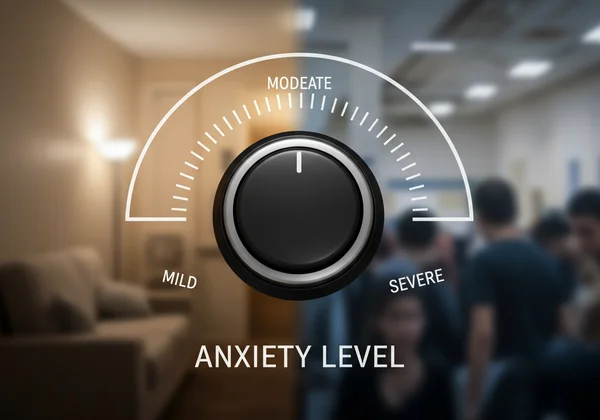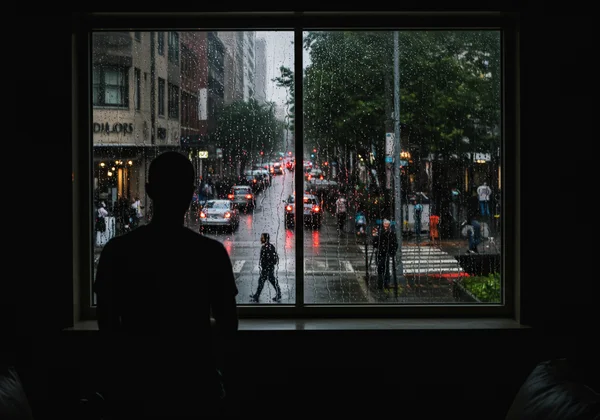Agoraphobia Test: Understanding the Mild, Moderate & Severe Spectrum
You feel an intense, churning fear in certain situations, but you're not completely housebound. You might dread the thought of a crowded supermarket or a long bus ride, yet you still manage to get through your day, albeit with a knot of anxiety in your stomach. This confusing middle ground leads many to ask the same question: Am I agoraphobic? The truth is, agoraphobia isn't a simple yes-or-no answer. It exists on a spectrum. Understanding where your experiences might fall on this spectrum is a crucial first step toward clarity, self-compassion, and effective management. An initial agoraphobia test can be an empowering tool to begin this journey of understanding.
Many people find that gaining insight into their personal symptom level is the first step toward feeling in control. A confidential self-assessment can provide a private space to explore these feelings without pressure. If you're curious about your own experiences, take our free online agoraphobia test for a preliminary risk assessment.
What is the Agoraphobia Spectrum?
The agoraphobia spectrum is a way of understanding that the condition's impact can range from subtle life adjustments to profound, life-altering avoidance. Instead of viewing it as an on-or-off switch, think of it as a dimmer dial. Some people experience a low hum of anxiety that makes certain situations uncomfortable, while for others, the fear is so overwhelming it significantly restricts their world. Recognizing this variation is key, as it validates the experiences of those who are struggling internally but may not fit the common stereotype of someone who never leaves their home.

Living with agoraphobia is not about a single fear but a pattern of anxiety and avoidance. Understanding this pattern is the first step toward addressing it. The goal is not to apply a label but to find the right language and tools for what you are experiencing.
It’s More Than Just a Fear of Open Spaces
A common misconception is that agoraphobia is simply the fear of open spaces. While that can be a component, it’s much broader. At its core, agoraphobia is a fear of situations where escape might be difficult or help might not be available if you have a panic-like reaction or other incapacitating or embarrassing symptoms. This fear typically centers on two or more of the following situations:
- Using public transportation (buses, trains, planes).
- Being in open spaces (parking lots, marketplaces, bridges).
- Being in enclosed places (shops, theaters, cinemas).
- Standing in line or being in a crowd.
- Being outside of the home alone.
The fear isn't of the places themselves, but of the overwhelming feeling of being trapped and helpless within them.
How the DSM-5 Criteria Hint at a Spectrum
The official diagnostic guide used by mental health professionals, the Diagnostic and Statistical Manual of Mental Disorders (DSM-5), implicitly supports the idea of a spectrum. For a diagnosis, a person must fear or avoid at least two of the five situations listed above. This very criterion suggests variability. Someone who fears all five situations and avoids them completely is experiencing a different level of severity than someone who fears two and still endures them with intense distress. This framework helps professionals and individuals alike understand the different levels of agoraphobia and tailor coping strategies accordingly.
Signs of Mild Agoraphobia: Subtle Avoidance
At the milder end of the agoraphobia spectrum, life might look relatively normal to an outside observer. The struggle is primarily internal. You are still functioning—going to work, seeing friends, and running errands—but it comes at a significant mental and emotional cost. This is often the most confusing stage, as you may question if your anxiety is "bad enough" to be a real problem.

If you suspect you may be experiencing these early signs, an agoraphobia symptoms test can help you quantify these feelings and see how they align with common patterns. It’s a completely private way to check in with yourself.
Feeling Anxious but Still Pushing Through
This is the hallmark of mild agoraphobia. You go on the bus, but you feel your heart pound the entire way. You stand in the grocery store line, but you’re mentally rehearsing your escape route. You experience anticipatory anxiety—dreading an upcoming event for days or weeks. While you don't let the fear stop you completely, it drains your energy and casts a shadow over activities that others seem to enjoy effortlessly. This constant state of high alert is exhausting and is a key indicator that something is amiss.
Making Small Changes to Your Routine
Subtle avoidance behavior is another key sign. You might not be avoiding entire categories of situations yet, but you are making small "safety" adjustments to your life. These can look like:
- Only driving on local roads to avoid highways.
- Choosing an aisle seat in a theater or on a plane for a quick exit.
- Going to the grocery store only during off-peak hours to avoid crowds.
- Always having your phone fully charged and knowing where the nearest exits are.
- Insisting on driving yourself so you can leave whenever you want.
These are clever coping mechanisms, but they are also the first building blocks of avoidance that can grow over time.
Understanding Moderate Agoraphobia: When Life Shrinks
At the moderate level, the impact of agoraphobia becomes much more visible and restrictive. The balance has tipped from "enduring with anxiety" to "actively avoiding." Your world begins to shrink as you systematically eliminate places and situations that trigger your fear. The condition is no longer just an internal battle; it is now dictating your choices and limiting your freedom. This is often when individuals or their loved ones realize that professional help is needed.

Actively Avoiding Multiple Types of Situations
Unlike the subtle shifts in mild agoraphobia, avoidance at the moderate level is overt and conscious. You might turn down social invitations that involve crowded venues, stop using public transport altogether, or rely entirely on grocery delivery to avoid stores. Your "no-go" list gets longer, and you may find yourself explaining away your decisions with excuses that hide the true reason: fear. This avoidance provides temporary relief but ultimately reinforces the anxiety, making the feared situations seem even more terrifying.
The Need for a "Safety Person" or Object
A defining feature of moderate agoraphobia is the reliance on a "safety person"—a trusted partner, friend, or family member without whom you feel unable to venture into feared situations. Their presence provides a sense of security that makes the unbearable feel manageable. You might also rely on safety objects, like a bottle of water, medication, or a cell phone, believing these items will help you cope if panic strikes. While helpful in the short term, this dependency can prevent you from building your own confidence in handling these situations alone.
Recognizing Severe Agoraphobia: Major Life Impact
This is the most debilitating end of the spectrum and the one most commonly portrayed in media. At this stage, agoraphobia has a profound and pervasive impact on nearly every aspect of a person's life. The fear is so intense and the avoidance so complete that the individual's world may be reduced to just a few "safe" places, often only their home. This level of agoraphobia can lead to significant isolation, depression, and an inability to work or maintain relationships. An online agoraphobia test can be a first step, even from home, to begin seeking help.

Being Housebound or Unable to Leave Home Alone
The most recognized sign of severe agoraphobia is being partially or completely housebound. The fear of experiencing a panic attack or intense anxiety outside the home is so overwhelming that leaving becomes an impossibility. Even trips to the mailbox or stepping onto the porch can feel like monumental challenges. At this stage, the person is almost always dependent on others for basic needs, like getting groceries and attending appointments. This is the ultimate expression of avoidance, where home has become the only place that feels safe from the terror of the outside world.
How Panic Attacks Fuel the Avoidance Cycle
In severe agoraphobia, panic attacks and avoidance are locked in a powerful, self-perpetuating cycle. The person experiences a terrifying panic attack in a public place. They then associate that place (and similar ones) with the intense fear of the attack. To prevent another attack, they avoid the place. This avoidance provides immediate relief, which the brain interprets as a reward, strengthening the belief that the situation is dangerous and avoidance is the correct response. Each act of avoidance makes the fear stronger and the world smaller.
Your First Step to Clarity and Control
Understanding that agoraphobia exists on a spectrum is liberating. It validates the struggles of those who are high-functioning but anxious, just as it acknowledges the severe limitations faced by those who are housebound. It’s not about finding a label to stick on yourself, but about gaining the clarity to say, "This is what I'm experiencing, and now I can do something about it."
No matter where you fall on the spectrum, the most important step is the first one. Acknowledging your feelings and seeking to understand them is an act of courage. If this article resonates with you, the next step is to gain personalized insight. Take our free, confidential, 2-minute agoraphobia self-assessment to receive an instant risk evaluation. It's a simple, private way to begin your journey toward managing your anxiety and reclaiming your life.
Common Questions About Agoraphobia Levels
Can you be agoraphobic and still leave the house?
Yes, absolutely. This is one of the biggest misconceptions about the condition. As we've explored, agoraphobia exists on a spectrum. Individuals with mild to moderate agoraphobia can and do leave their homes, but they often do so with significant anxiety, by using specific coping strategies, or by only venturing into "safe" zones or with a "safety person." Being housebound is characteristic of the severe end of the spectrum, not a requirement for the condition.
What can agoraphobia be mistaken for?
Agoraphobia is often confused with other anxiety disorders. It can be mistaken for Social Anxiety Disorder (where the fear is of social judgment, not of being trapped), Panic Disorder (many with agoraphobia also have panic disorder, but the key is the avoidance of places out of fear of a panic attack), or Specific Phobias (like claustrophobia, the fear of enclosed spaces). The key differentiator for agoraphobia is the pattern of avoiding multiple types of situations due to the fear of being unable to escape or get help.
How do you test for agoraphobia?
A formal diagnosis must be made by a qualified healthcare professional, such as a psychologist or psychiatrist, through a clinical interview. However, the journey to diagnosis often begins with self-reflection. A validated agoraphobia screening test can be an excellent first step. It helps you organize your thoughts and symptoms, providing a baseline understanding of your risk level that can be a valuable starting point for a conversation with a doctor. A good starting point is a confidential online assessment tool like ours.